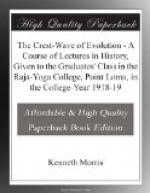It is, so far, and with so little translated, extremely hard to get at the undercurrents in these old Chinese periods; but I suspect a strong spiritual influence, Buddhist at that, in the great events of the years that followed. For China proceeded to strike into history in such a way that the blow resounded, if not round the world, at least round as much of it as was discovered before Columbus; and she did it in such a nice, clean, artistic and quiet way, and withal so thoroughly, that I cannot help feeling that that glorious warriorlike Northern Buddhism of the Mahayana had something to do with it.
It was not Han Mingti himself who did it, but one of his sevants; of whom, it is likely, you have never heard; although east or west there have been, probably, but one or two of his trade so great as he, or who have mattered so much to history. His name was Pan Chow; his trade, soldiering. He began his career of conquest about the time the major Han Cycle was due to recur,—in the sixties; maintained it through three reigns, and ended it at his death about when the Eastern Han half-cycle, started in 35, was due to close;—somewhere, that is, about 100 A.D., while Trajan was beginning a new day and career of conquest in Rome.
XXI. CHINA AND ROME: THE SEE-SAW (CONTINUED)
During the time of Chinese weakness Central Asia had relapsed from the control the great Han Wuti had imposed on it, and that Han Suenti had maintained by his name for justice; and the Huns had recovered their power. One wonders what these people were; of whom we first catch sight in the reign of the Yellow Emperor, nearly 3000 B.C.; and who do not disappear from history until after the death of Attila. During all those three millenniums odd they were predatory nomads, never civilized: a curse to their betters, and nothing more. And their betters were, you may say, every race they contacted.
It seems as if, as in the human blood, so among the races of mankind, there were builders and destroyers. I speculate as to the beginnings of the latter: they cannot be . . . races apart, of some special creation;—made by demons, where it was the Gods made men. . . . “To the Huns,” says Gibbon, “a fabulous origin was assigned worthy of their form and manners,—that the witches of Scythia, who for their foul and deadly




